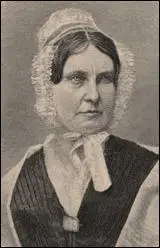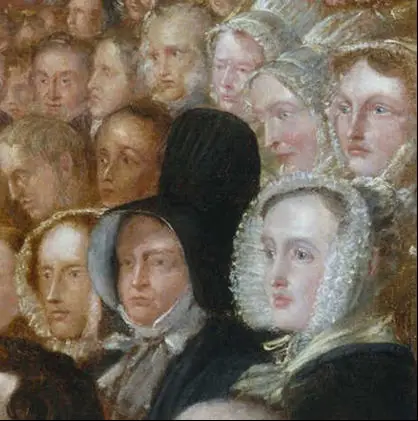Elizabeth Pease

Elizabeth Pease, the daughter of Joseph Pease and Elizabeth Beaumont Pease, was born in Darlington on 5th January 1807. Her father was a wool manufacturer and along with his wife were Quakers who played a leading role in philanthropic and humanitarian movements. Elizabeth was educated at a local school and then by a governess, but her studies were disrupted by nursing her sick mother who died in 1824. (1)
Elizabeth came from a family heavily involved in the struggle for social reform. She was related to Isabella Ford and was close to Harriet Martineau. Elizabeth worked as her father's secretary in the campaign's for Catholic Emancipation, abolition of the Test Acts and the struggle against slavery. (2)
In 1824 Elizabeth Heyrick published her pamphlet Immediate not Gradual Abolition. In her pamphlet Heyrick argued passionately in favour of the immediate emancipation of the slaves in the British colonies. This differed from the official policy of the Anti-Slavery Society that believed in gradual abolition. She called this "the very masterpiece of satanic policy" and called for a boycott of the sugar produced on slave plantations. (3)
In the pamphlet Heyrick attacked the "slow, cautious, accommodating measures" of the leaders. "The perpetuation of slavery in our West India colonies is not an abstract question, to be settled between the government and the planters; it is one in which we are all implicated, we are all guilty of supporting and perpetuating slavery. The West Indian planter and the people of this country stand in the same moral relation to each other as the thief and receiver of stolen goods". (4)
Elizabeth Pease & Anti-Slavery Movement
William Wilberforce and other leaders of the Anti-Slavery Society were upset by Heyrick's views and attempts were made to suppress information about the existence of this pamphlet. Wilberforce's biographer, William Hague, claims that Wilberforce was unable to adjust to the idea of women becoming involved in politics "occurring as this did nearly a century before women would be given the vote in Britain". (5)
Elizabeth Pease and most of the women involved in the campaign against slavery agreed with Heyrick. Although women were allowed to be members they were virtually excluded from its leadership. Wilberforce disliked to militancy of the women and wrote to Thomas Babington protesting that "for ladies to meet, to publish, to go from house to house stirring up petitions - these appear to me proceedings unsuited to the female character as delineated in Scripture". (6)
On 8th April, 1825, Lucy Townsend held a meeting at her home to discuss the issue of the role of women in the anti-slavery movement. Townsend, Elizabeth Heyrick, Mary Lloyd, Sarah Wedgwood, Sophia Sturge and the other women at the meeting decided to form the Birmingham Ladies Society for the Relief of Negro Slaves (later the group changed its name to the Female Society for Birmingham). (7) The group "promoted the sugar boycott, targeting shops as well as shoppers, visiting thousands of homes and distributing pamphlets, calling meetings and drawing petitions." (8)
The society which was, from its foundation, independent of both the national Anti-Slavery Society and of the local men's anti-slavery society. As Clare Midgley has pointed out: "It acted as the hub of a developing national network of female anti-slavery societies, rather than as a local auxiliary. It also had important international connections, and publicity on its activities in Benjamin Lundy's abolitionist periodical The Genius of Universal Emancipation influenced the formation of the first female anti-slavery societies in America". (9)
Elizabeth Pease formed a women's group in Darlington. Other groups were established in Nottingham (Ann Taylor Gilbert), Sheffield (Mary Anne Rawson, Mary Roberts), Leicester (Elizabeth Heyrick, Susanna Watts), Glasgow (Jane Smeal), Norwich (Amelia Opie, Anna Gurney), London (Mary Anne Schimmelpenninck, Mary Foster) and Chelmsford (Anne Knight). By 1831 there were seventy-three of these women's organisations campaigning against slavery. (10)
She supported the campaign for the 1832 Reform Act which enabled Joseph Pease, to become Britain's first Quaker member of the House of Commons. However, unlike most middle-class reformers, Elizabeth was not satisfied with this measure and along with her close friend, Anne Knight, became a supporter of the campaign for universal suffrage.
The Slavery Abolition Act was passed on 28th August 1833. This act gave all slaves in the British Empire their freedom. The British government paid £20 million in compensation to the slave owners. The amount that the plantation owners received depended on the number of slaves that they had. For example, Henry Phillpotts, the Bishop of Exeter, received £12,700 for the 665 slaves he owned. (11)
Pease joined forces with her friend Jane Smeal of Glasgow to campaign for universal suffrage. Smeal pointed out: "The females in this city who have much leisure for philanthropic objects are I believe very numerous - but unhappily that is not the class who take an active part in the cause here - neither the noble, the rich, nor the learned are to be found advocating our cause. Our subscribers and most efficient members are all in the middling and working classes but they have great zeal and labour very harmoniously together." (12)
In March 1838, Elizabeth and Jane Smeal published a pamphlet, Address to the Women of Great Britain, where they urged women to organise female political associations. She fostered links between female anti-slavery societies in Britain and the United States, and she became one of the leading British promoters of the radical wing of the movement which was led by William Lloyd Garrison. Pease also engaged in an extensive correspondence with American abolitionists. (13)
World Anti-Slavery Convention
Elizabeth Pease attended the World Anti-Slavery Convention held at Exeter Hall in London, in June 1840 but as a woman was refused permission to speak. However, she did take the opportunity to meet American abolitionists, such as Lucretia Mott and Elizabeth Cady Stanton. Mott later commented that Pease was "a fine noble-looking girl". (14)
Anne Knight became aware that the artist, Benjamin Robert Haydon, had started a group portrait of those involved in the fight against slavery. She wrote a letter to Lucy Townsend complaining about the lack of women in the painting. "I am very anxious that the historical picture now in the hand of Haydon should not be performed without the chief lady of the history being there in justice to history and posterity the person who established (women's anti-slavery groups). You have as much right to be there as Thomas Clarkson himself, nay perhaps more, his achievement was in the slave trade; thine was slavery itself the pervading movement." (15)

showing from left to right, bottom row: Annabella Byron, Amelia Opie,
Mary Anne Rawson, top row, Anne Knight, Mrs John Beaumont and Elizabeth Pease.
When the painting was completed it did include Elizabeth Pease. Clare Midgley, the author of Women Against Slavery (1995) points out that it also featured Mary Anne Rawson, Amelia Opie and Annabella Byron: "Haydon's group portrait is exceptional in that it does record the existence of women campaigners. Most other memorials did not. There are no public monuments to women activists to complement those to William Wilberforce, Thomas Clarkson and other male leaders of the movement... In the written memoirs of these men, women tend to appear as helpful and inspirational wives, mothers and daughters rather than as activists in their own right." (16)
Parliamentary Reform
Elizabeth Pease was a great advocate of women becoming involved in politics. She wrote to her friend, John Collins: "I believe there are few persons whose natural feelings are so opposed to women appearing prominently before the public, as mine - but viewed in the light of principle I see, the prejudice - custom and other feelings which will not stand the test of truth, are at the bottom, and must be laid aside." (17)
In 1842 Elizabeth Pease became a Chartist: "I believe the Chartists generally hold the doctrine of the equality of women's rights - but, I am not sure whether they do not consider that when she marries, she merges her political rights with those of her husband." (18) She argued passionately for social reform: "The grand principle of the natural equality of man - a principle alas almost buried, in the land, beneath the rubbish of an hereditary aristocracy and the force of a state religion. Working people are driven almost to desperation by those who consider they are but chattels made to minister to their luxury and add to their wealth." (19)
Elizabeth Pease married Dr John Pringle Nichol, regius professor of astronomy at the University of Glasgow on 6th July 1853. He was a Presbyterian, and Elizabeth was disowned by the Society of Friends for "marrying out". Pease left the family home in Darlington to live with her husband in Glasgow until his death in 1859. Elizabeth was a member of the Peace Society and the Temperance Society also took part in the anti-vivisection campaign. She publicly supported women's struggle to gain medical training at Edinburgh University; she became a member of the Edinburgh committee of the Ladies' Educational Association. (20)
In February 1880 Elizabeth was present at the Great Demonstration of Women at the Free Trade Hall in Manchester. She pointed out that some of her friends considered her to be "ungenteel" and "vulgar" because she was a supporter of universal suffrage. Elizabeth also signed the "Letter from Ladies to Members of Parliament", asking for the inclusion of women heads of householders in the 1884 Reform Act. (21)
Elizabeth Pease Nichol, died aged 90, on 3rd February 1897 at her home, Huntly Lodge, in Edinburgh, and was buried on 8th February alongside her husband in Grange Cemetery.
Primary Sources
(1) Elizabeth Pease attempted to persuade working-class women in Darlington to join the campaign against slavery. Her friend, Jane Smeal, from Glasgow, wrote to her about this matter in 1836.
The females in this city who have much leisure for philanthropic objects are I believe very numerous - but unhappily that is not the class who take an active part in the cause here - neither the noble, the rich, nor the learned are to be found advocating our cause. Our subscribers and most efficient members are all in the middling and working classes but they have great zeal and labour very harmoniously together.
(2) Elizabeth Pease, letter to John Collins (14th December, 1840)
I believe there are few persons whose natural feelings are so opposed to women appearing prominently before the public, as mine - but viewed in the light of principle I see, the prejudice - custom and other feelings which will not stand the test of truth, are at the bottom, and must be laid aside.
(3) Elizabeth Pease, letter to Anne Phillips (29th September, 1842)
The grand principle of the natural equality of man - a principle alas almost buried, in the land, beneath the rubbish of an hereditary aristocracy and the force of a state religion. Working people are driven almost to desperation by those who consider they are but chattels made to minister to their luxury and add to their wealth.
Student Activities
Child Labour Simulation (Teacher Notes)
Richard Arkwright and the Factory System (Answer Commentary)
Robert Owen and New Lanark (Answer Commentary)
James Watt and Steam Power (Answer Commentary)
The Domestic System (Answer Commentary)
The Luddites: 1775-1825 (Answer Commentary)
The Plight of the Handloom Weavers (Answer Commentary)
Road Transport and the Industrial Revolution (Answer Commentary)
